Analyzing Emotional Intelligence at Constellations Café Store
VerifiedAdded on 2023/05/30
|6
|1891
|55
Report
AI Summary
This report examines the emotional intelligence dynamics within Constellations Café, a setting marked by frequent conflicts and strained team relations. It identifies the cultural demographics of the work team, assesses the emotional needs of its members, and outlines the leadership requirements for understanding and addressing emotional expressions. The report emphasizes the importance of flexibility and adaptability in conflict resolution, proposing actions such as brief personal meetings to understand worker concerns. It also highlights the necessity of developing emotional intelligence among team members through training sessions focused on self-control and self-awareness. Furthermore, the report suggests strategies to encourage team member expressiveness, rates the current emotional climate, and recommends improvements through interactive sessions and team games. By identifying current emotional strengths and modeling desired emotional intelligence skills, the report concludes that fostering a friendly, ethical, and professional environment is crucial, prioritizing service and understanding over emotional conflicts. Desklib offers a wide array of similar solved assignments and past papers.

Develop and Use Emotional Intelligence
Paraphrase This Document
Need a fresh take? Get an instant paraphrase of this document with our AI Paraphraser
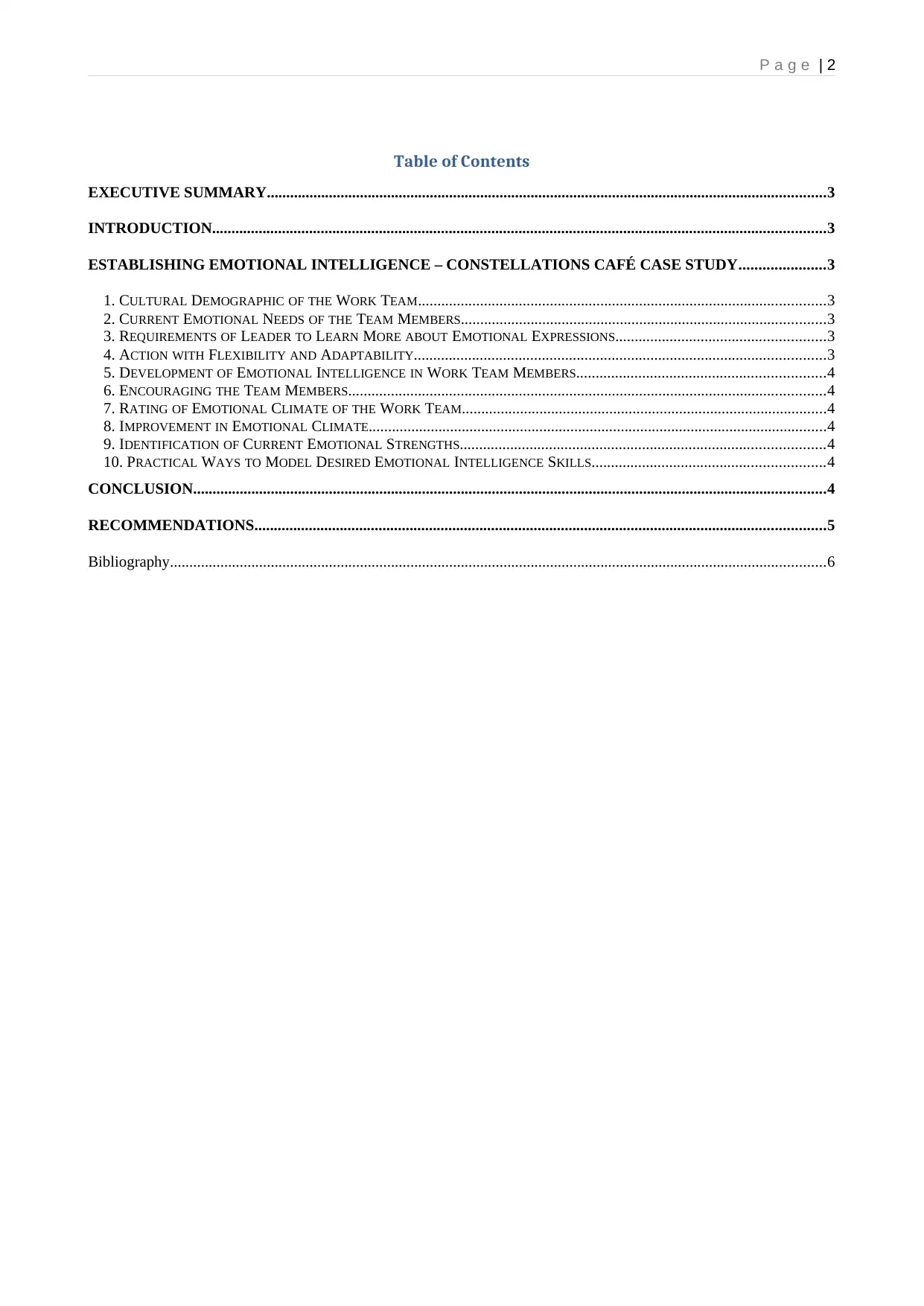
P a g e | 2
Table of Contents
EXECUTIVE SUMMARY................................................................................................................................................3
INTRODUCTION..............................................................................................................................................................3
ESTABLISHING EMOTIONAL INTELLIGENCE – CONSTELLATIONS CAFÉ CASE STUDY......................3
1. CULTURAL DEMOGRAPHIC OF THE WORK TEAM.........................................................................................................3
2. CURRENT EMOTIONAL NEEDS OF THE TEAM MEMBERS..............................................................................................3
3. REQUIREMENTS OF LEADER TO LEARN MORE ABOUT EMOTIONAL EXPRESSIONS......................................................3
4. ACTION WITH FLEXIBILITY AND ADAPTABILITY..........................................................................................................3
5. DEVELOPMENT OF EMOTIONAL INTELLIGENCE IN WORK TEAM MEMBERS................................................................4
6. ENCOURAGING THE TEAM MEMBERS...........................................................................................................................4
7. RATING OF EMOTIONAL CLIMATE OF THE WORK TEAM..............................................................................................4
8. IMPROVEMENT IN EMOTIONAL CLIMATE......................................................................................................................4
9. IDENTIFICATION OF CURRENT EMOTIONAL STRENGTHS..............................................................................................4
10. PRACTICAL WAYS TO MODEL DESIRED EMOTIONAL INTELLIGENCE SKILLS............................................................4
CONCLUSION...................................................................................................................................................................4
RECOMMENDATIONS...................................................................................................................................................5
Bibliography.........................................................................................................................................................................6
Table of Contents
EXECUTIVE SUMMARY................................................................................................................................................3
INTRODUCTION..............................................................................................................................................................3
ESTABLISHING EMOTIONAL INTELLIGENCE – CONSTELLATIONS CAFÉ CASE STUDY......................3
1. CULTURAL DEMOGRAPHIC OF THE WORK TEAM.........................................................................................................3
2. CURRENT EMOTIONAL NEEDS OF THE TEAM MEMBERS..............................................................................................3
3. REQUIREMENTS OF LEADER TO LEARN MORE ABOUT EMOTIONAL EXPRESSIONS......................................................3
4. ACTION WITH FLEXIBILITY AND ADAPTABILITY..........................................................................................................3
5. DEVELOPMENT OF EMOTIONAL INTELLIGENCE IN WORK TEAM MEMBERS................................................................4
6. ENCOURAGING THE TEAM MEMBERS...........................................................................................................................4
7. RATING OF EMOTIONAL CLIMATE OF THE WORK TEAM..............................................................................................4
8. IMPROVEMENT IN EMOTIONAL CLIMATE......................................................................................................................4
9. IDENTIFICATION OF CURRENT EMOTIONAL STRENGTHS..............................................................................................4
10. PRACTICAL WAYS TO MODEL DESIRED EMOTIONAL INTELLIGENCE SKILLS............................................................4
CONCLUSION...................................................................................................................................................................4
RECOMMENDATIONS...................................................................................................................................................5
Bibliography.........................................................................................................................................................................6
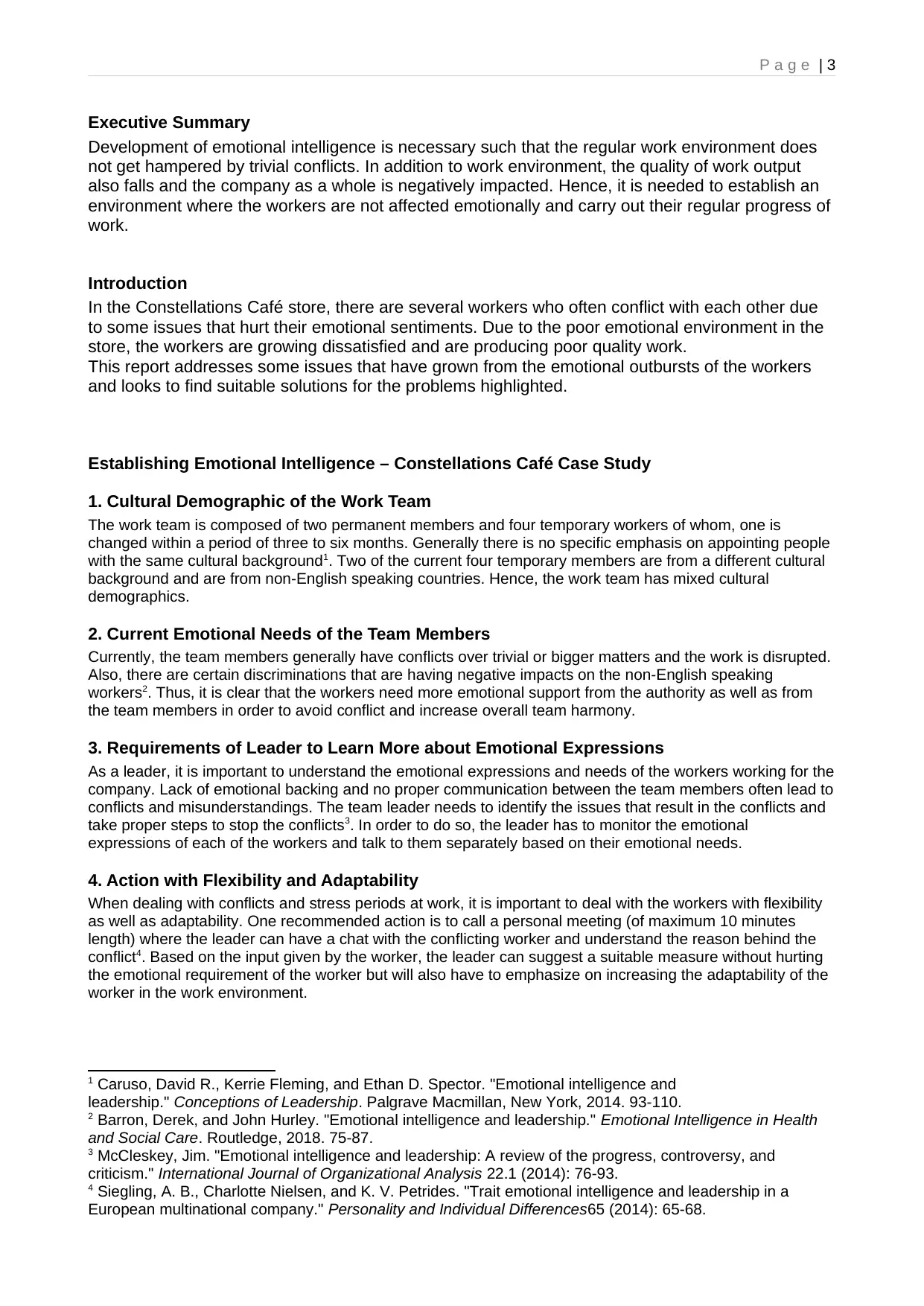
P a g e | 3
Executive Summary
Development of emotional intelligence is necessary such that the regular work environment does
not get hampered by trivial conflicts. In addition to work environment, the quality of work output
also falls and the company as a whole is negatively impacted. Hence, it is needed to establish an
environment where the workers are not affected emotionally and carry out their regular progress of
work.
Introduction
In the Constellations Café store, there are several workers who often conflict with each other due
to some issues that hurt their emotional sentiments. Due to the poor emotional environment in the
store, the workers are growing dissatisfied and are producing poor quality work.
This report addresses some issues that have grown from the emotional outbursts of the workers
and looks to find suitable solutions for the problems highlighted.
Establishing Emotional Intelligence – Constellations Café Case Study
1. Cultural Demographic of the Work Team
The work team is composed of two permanent members and four temporary workers of whom, one is
changed within a period of three to six months. Generally there is no specific emphasis on appointing people
with the same cultural background1. Two of the current four temporary members are from a different cultural
background and are from non-English speaking countries. Hence, the work team has mixed cultural
demographics.
2. Current Emotional Needs of the Team Members
Currently, the team members generally have conflicts over trivial or bigger matters and the work is disrupted.
Also, there are certain discriminations that are having negative impacts on the non-English speaking
workers2. Thus, it is clear that the workers need more emotional support from the authority as well as from
the team members in order to avoid conflict and increase overall team harmony.
3. Requirements of Leader to Learn More about Emotional Expressions
As a leader, it is important to understand the emotional expressions and needs of the workers working for the
company. Lack of emotional backing and no proper communication between the team members often lead to
conflicts and misunderstandings. The team leader needs to identify the issues that result in the conflicts and
take proper steps to stop the conflicts3. In order to do so, the leader has to monitor the emotional
expressions of each of the workers and talk to them separately based on their emotional needs.
4. Action with Flexibility and Adaptability
When dealing with conflicts and stress periods at work, it is important to deal with the workers with flexibility
as well as adaptability. One recommended action is to call a personal meeting (of maximum 10 minutes
length) where the leader can have a chat with the conflicting worker and understand the reason behind the
conflict4. Based on the input given by the worker, the leader can suggest a suitable measure without hurting
the emotional requirement of the worker but will also have to emphasize on increasing the adaptability of the
worker in the work environment.
1 Caruso, David R., Kerrie Fleming, and Ethan D. Spector. "Emotional intelligence and
leadership." Conceptions of Leadership. Palgrave Macmillan, New York, 2014. 93-110.
2 Barron, Derek, and John Hurley. "Emotional intelligence and leadership." Emotional Intelligence in Health
and Social Care. Routledge, 2018. 75-87.
3 McCleskey, Jim. "Emotional intelligence and leadership: A review of the progress, controversy, and
criticism." International Journal of Organizational Analysis 22.1 (2014): 76-93.
4 Siegling, A. B., Charlotte Nielsen, and K. V. Petrides. "Trait emotional intelligence and leadership in a
European multinational company." Personality and Individual Differences65 (2014): 65-68.
Executive Summary
Development of emotional intelligence is necessary such that the regular work environment does
not get hampered by trivial conflicts. In addition to work environment, the quality of work output
also falls and the company as a whole is negatively impacted. Hence, it is needed to establish an
environment where the workers are not affected emotionally and carry out their regular progress of
work.
Introduction
In the Constellations Café store, there are several workers who often conflict with each other due
to some issues that hurt their emotional sentiments. Due to the poor emotional environment in the
store, the workers are growing dissatisfied and are producing poor quality work.
This report addresses some issues that have grown from the emotional outbursts of the workers
and looks to find suitable solutions for the problems highlighted.
Establishing Emotional Intelligence – Constellations Café Case Study
1. Cultural Demographic of the Work Team
The work team is composed of two permanent members and four temporary workers of whom, one is
changed within a period of three to six months. Generally there is no specific emphasis on appointing people
with the same cultural background1. Two of the current four temporary members are from a different cultural
background and are from non-English speaking countries. Hence, the work team has mixed cultural
demographics.
2. Current Emotional Needs of the Team Members
Currently, the team members generally have conflicts over trivial or bigger matters and the work is disrupted.
Also, there are certain discriminations that are having negative impacts on the non-English speaking
workers2. Thus, it is clear that the workers need more emotional support from the authority as well as from
the team members in order to avoid conflict and increase overall team harmony.
3. Requirements of Leader to Learn More about Emotional Expressions
As a leader, it is important to understand the emotional expressions and needs of the workers working for the
company. Lack of emotional backing and no proper communication between the team members often lead to
conflicts and misunderstandings. The team leader needs to identify the issues that result in the conflicts and
take proper steps to stop the conflicts3. In order to do so, the leader has to monitor the emotional
expressions of each of the workers and talk to them separately based on their emotional needs.
4. Action with Flexibility and Adaptability
When dealing with conflicts and stress periods at work, it is important to deal with the workers with flexibility
as well as adaptability. One recommended action is to call a personal meeting (of maximum 10 minutes
length) where the leader can have a chat with the conflicting worker and understand the reason behind the
conflict4. Based on the input given by the worker, the leader can suggest a suitable measure without hurting
the emotional requirement of the worker but will also have to emphasize on increasing the adaptability of the
worker in the work environment.
1 Caruso, David R., Kerrie Fleming, and Ethan D. Spector. "Emotional intelligence and
leadership." Conceptions of Leadership. Palgrave Macmillan, New York, 2014. 93-110.
2 Barron, Derek, and John Hurley. "Emotional intelligence and leadership." Emotional Intelligence in Health
and Social Care. Routledge, 2018. 75-87.
3 McCleskey, Jim. "Emotional intelligence and leadership: A review of the progress, controversy, and
criticism." International Journal of Organizational Analysis 22.1 (2014): 76-93.
4 Siegling, A. B., Charlotte Nielsen, and K. V. Petrides. "Trait emotional intelligence and leadership in a
European multinational company." Personality and Individual Differences65 (2014): 65-68.
⊘ This is a preview!⊘
Do you want full access?
Subscribe today to unlock all pages.

Trusted by 1+ million students worldwide
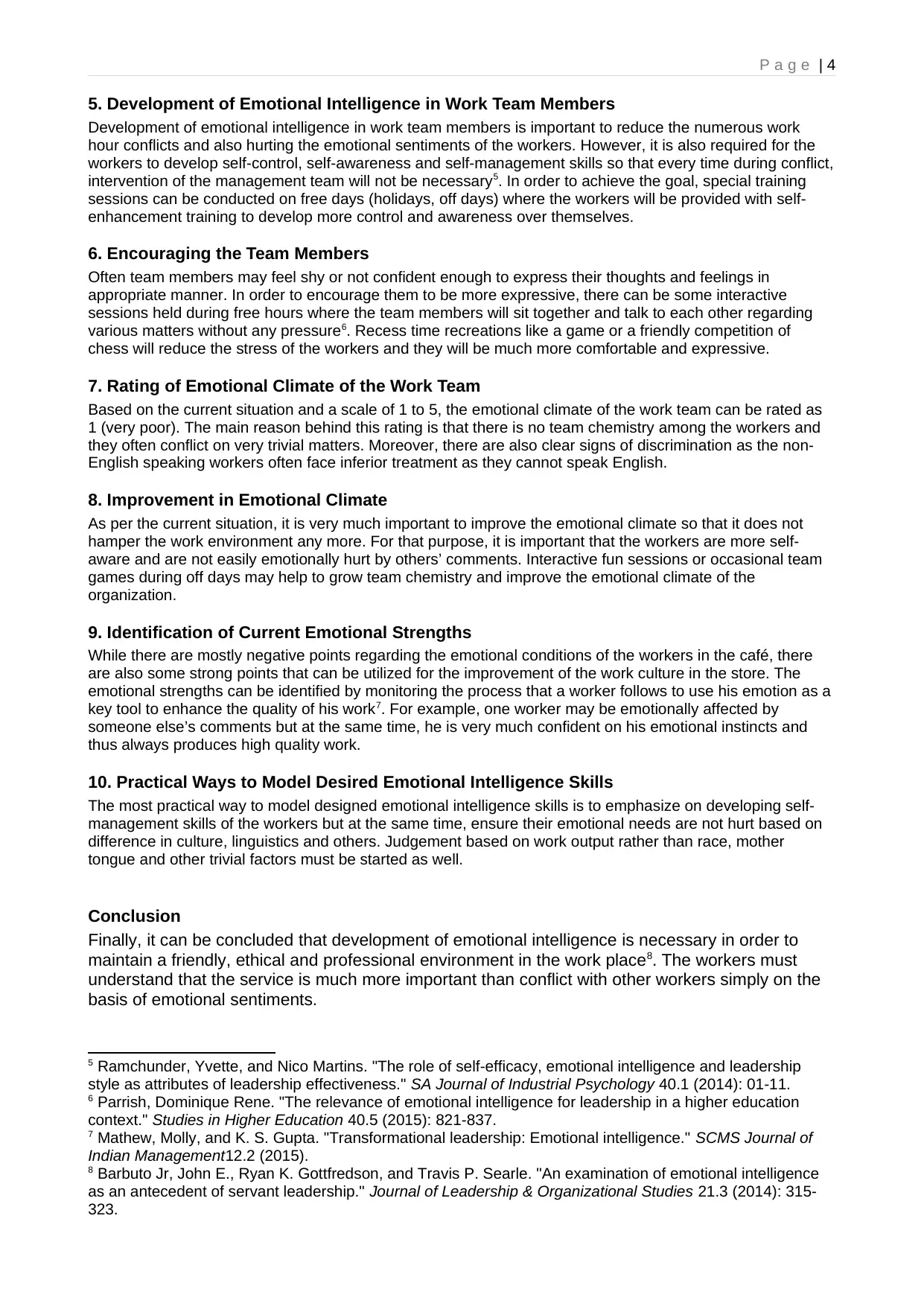
P a g e | 4
5. Development of Emotional Intelligence in Work Team Members
Development of emotional intelligence in work team members is important to reduce the numerous work
hour conflicts and also hurting the emotional sentiments of the workers. However, it is also required for the
workers to develop self-control, self-awareness and self-management skills so that every time during conflict,
intervention of the management team will not be necessary5. In order to achieve the goal, special training
sessions can be conducted on free days (holidays, off days) where the workers will be provided with self-
enhancement training to develop more control and awareness over themselves.
6. Encouraging the Team Members
Often team members may feel shy or not confident enough to express their thoughts and feelings in
appropriate manner. In order to encourage them to be more expressive, there can be some interactive
sessions held during free hours where the team members will sit together and talk to each other regarding
various matters without any pressure6. Recess time recreations like a game or a friendly competition of
chess will reduce the stress of the workers and they will be much more comfortable and expressive.
7. Rating of Emotional Climate of the Work Team
Based on the current situation and a scale of 1 to 5, the emotional climate of the work team can be rated as
1 (very poor). The main reason behind this rating is that there is no team chemistry among the workers and
they often conflict on very trivial matters. Moreover, there are also clear signs of discrimination as the non-
English speaking workers often face inferior treatment as they cannot speak English.
8. Improvement in Emotional Climate
As per the current situation, it is very much important to improve the emotional climate so that it does not
hamper the work environment any more. For that purpose, it is important that the workers are more self-
aware and are not easily emotionally hurt by others’ comments. Interactive fun sessions or occasional team
games during off days may help to grow team chemistry and improve the emotional climate of the
organization.
9. Identification of Current Emotional Strengths
While there are mostly negative points regarding the emotional conditions of the workers in the café, there
are also some strong points that can be utilized for the improvement of the work culture in the store. The
emotional strengths can be identified by monitoring the process that a worker follows to use his emotion as a
key tool to enhance the quality of his work7. For example, one worker may be emotionally affected by
someone else’s comments but at the same time, he is very much confident on his emotional instincts and
thus always produces high quality work.
10. Practical Ways to Model Desired Emotional Intelligence Skills
The most practical way to model designed emotional intelligence skills is to emphasize on developing self-
management skills of the workers but at the same time, ensure their emotional needs are not hurt based on
difference in culture, linguistics and others. Judgement based on work output rather than race, mother
tongue and other trivial factors must be started as well.
Conclusion
Finally, it can be concluded that development of emotional intelligence is necessary in order to
maintain a friendly, ethical and professional environment in the work place8. The workers must
understand that the service is much more important than conflict with other workers simply on the
basis of emotional sentiments.
5 Ramchunder, Yvette, and Nico Martins. "The role of self-efficacy, emotional intelligence and leadership
style as attributes of leadership effectiveness." SA Journal of Industrial Psychology 40.1 (2014): 01-11.
6 Parrish, Dominique Rene. "The relevance of emotional intelligence for leadership in a higher education
context." Studies in Higher Education 40.5 (2015): 821-837.
7 Mathew, Molly, and K. S. Gupta. "Transformational leadership: Emotional intelligence." SCMS Journal of
Indian Management12.2 (2015).
8 Barbuto Jr, John E., Ryan K. Gottfredson, and Travis P. Searle. "An examination of emotional intelligence
as an antecedent of servant leadership." Journal of Leadership & Organizational Studies 21.3 (2014): 315-
323.
5. Development of Emotional Intelligence in Work Team Members
Development of emotional intelligence in work team members is important to reduce the numerous work
hour conflicts and also hurting the emotional sentiments of the workers. However, it is also required for the
workers to develop self-control, self-awareness and self-management skills so that every time during conflict,
intervention of the management team will not be necessary5. In order to achieve the goal, special training
sessions can be conducted on free days (holidays, off days) where the workers will be provided with self-
enhancement training to develop more control and awareness over themselves.
6. Encouraging the Team Members
Often team members may feel shy or not confident enough to express their thoughts and feelings in
appropriate manner. In order to encourage them to be more expressive, there can be some interactive
sessions held during free hours where the team members will sit together and talk to each other regarding
various matters without any pressure6. Recess time recreations like a game or a friendly competition of
chess will reduce the stress of the workers and they will be much more comfortable and expressive.
7. Rating of Emotional Climate of the Work Team
Based on the current situation and a scale of 1 to 5, the emotional climate of the work team can be rated as
1 (very poor). The main reason behind this rating is that there is no team chemistry among the workers and
they often conflict on very trivial matters. Moreover, there are also clear signs of discrimination as the non-
English speaking workers often face inferior treatment as they cannot speak English.
8. Improvement in Emotional Climate
As per the current situation, it is very much important to improve the emotional climate so that it does not
hamper the work environment any more. For that purpose, it is important that the workers are more self-
aware and are not easily emotionally hurt by others’ comments. Interactive fun sessions or occasional team
games during off days may help to grow team chemistry and improve the emotional climate of the
organization.
9. Identification of Current Emotional Strengths
While there are mostly negative points regarding the emotional conditions of the workers in the café, there
are also some strong points that can be utilized for the improvement of the work culture in the store. The
emotional strengths can be identified by monitoring the process that a worker follows to use his emotion as a
key tool to enhance the quality of his work7. For example, one worker may be emotionally affected by
someone else’s comments but at the same time, he is very much confident on his emotional instincts and
thus always produces high quality work.
10. Practical Ways to Model Desired Emotional Intelligence Skills
The most practical way to model designed emotional intelligence skills is to emphasize on developing self-
management skills of the workers but at the same time, ensure their emotional needs are not hurt based on
difference in culture, linguistics and others. Judgement based on work output rather than race, mother
tongue and other trivial factors must be started as well.
Conclusion
Finally, it can be concluded that development of emotional intelligence is necessary in order to
maintain a friendly, ethical and professional environment in the work place8. The workers must
understand that the service is much more important than conflict with other workers simply on the
basis of emotional sentiments.
5 Ramchunder, Yvette, and Nico Martins. "The role of self-efficacy, emotional intelligence and leadership
style as attributes of leadership effectiveness." SA Journal of Industrial Psychology 40.1 (2014): 01-11.
6 Parrish, Dominique Rene. "The relevance of emotional intelligence for leadership in a higher education
context." Studies in Higher Education 40.5 (2015): 821-837.
7 Mathew, Molly, and K. S. Gupta. "Transformational leadership: Emotional intelligence." SCMS Journal of
Indian Management12.2 (2015).
8 Barbuto Jr, John E., Ryan K. Gottfredson, and Travis P. Searle. "An examination of emotional intelligence
as an antecedent of servant leadership." Journal of Leadership & Organizational Studies 21.3 (2014): 315-
323.
Paraphrase This Document
Need a fresh take? Get an instant paraphrase of this document with our AI Paraphraser
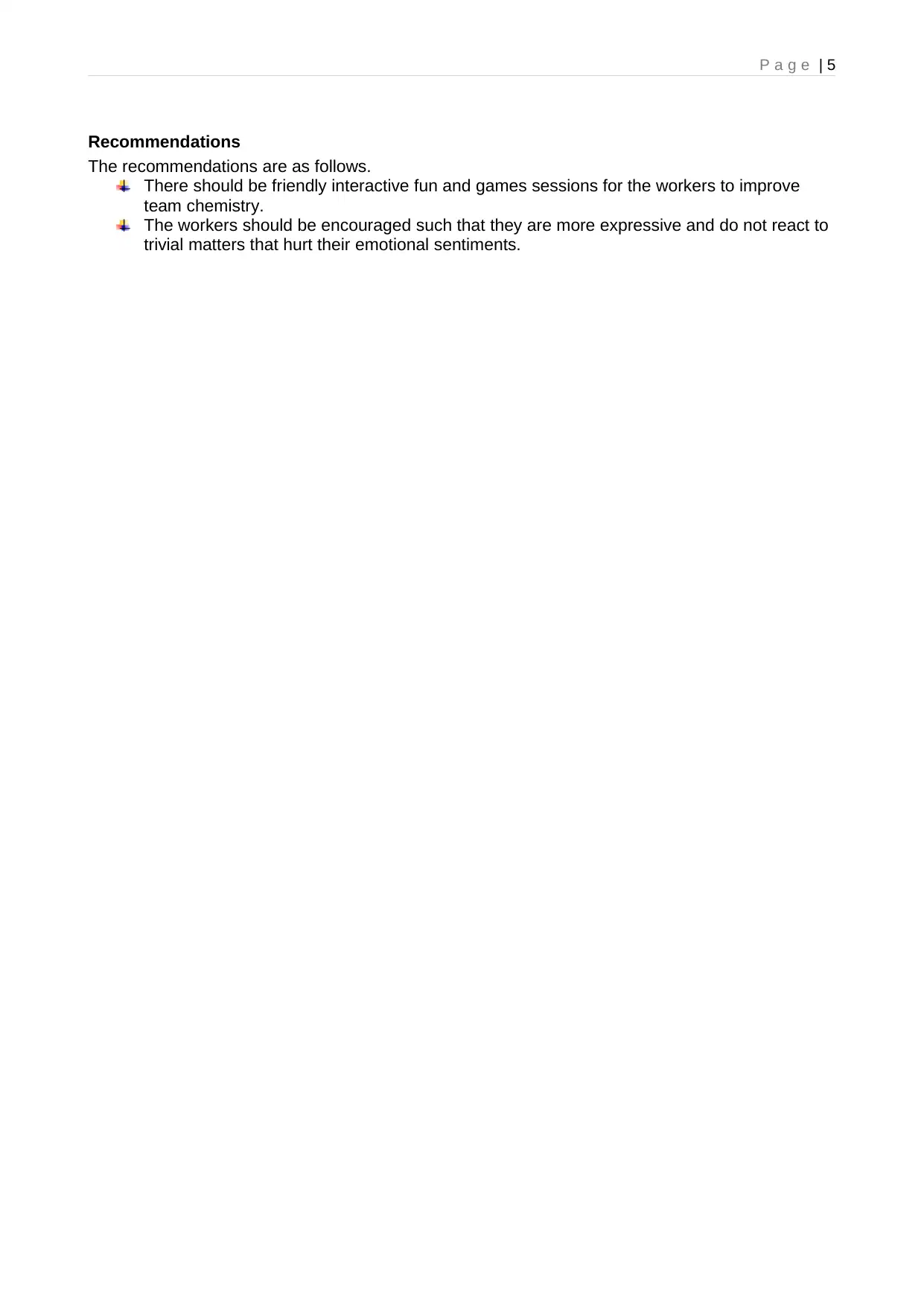
P a g e | 5
Recommendations
The recommendations are as follows.
There should be friendly interactive fun and games sessions for the workers to improve
team chemistry.
The workers should be encouraged such that they are more expressive and do not react to
trivial matters that hurt their emotional sentiments.
Recommendations
The recommendations are as follows.
There should be friendly interactive fun and games sessions for the workers to improve
team chemistry.
The workers should be encouraged such that they are more expressive and do not react to
trivial matters that hurt their emotional sentiments.
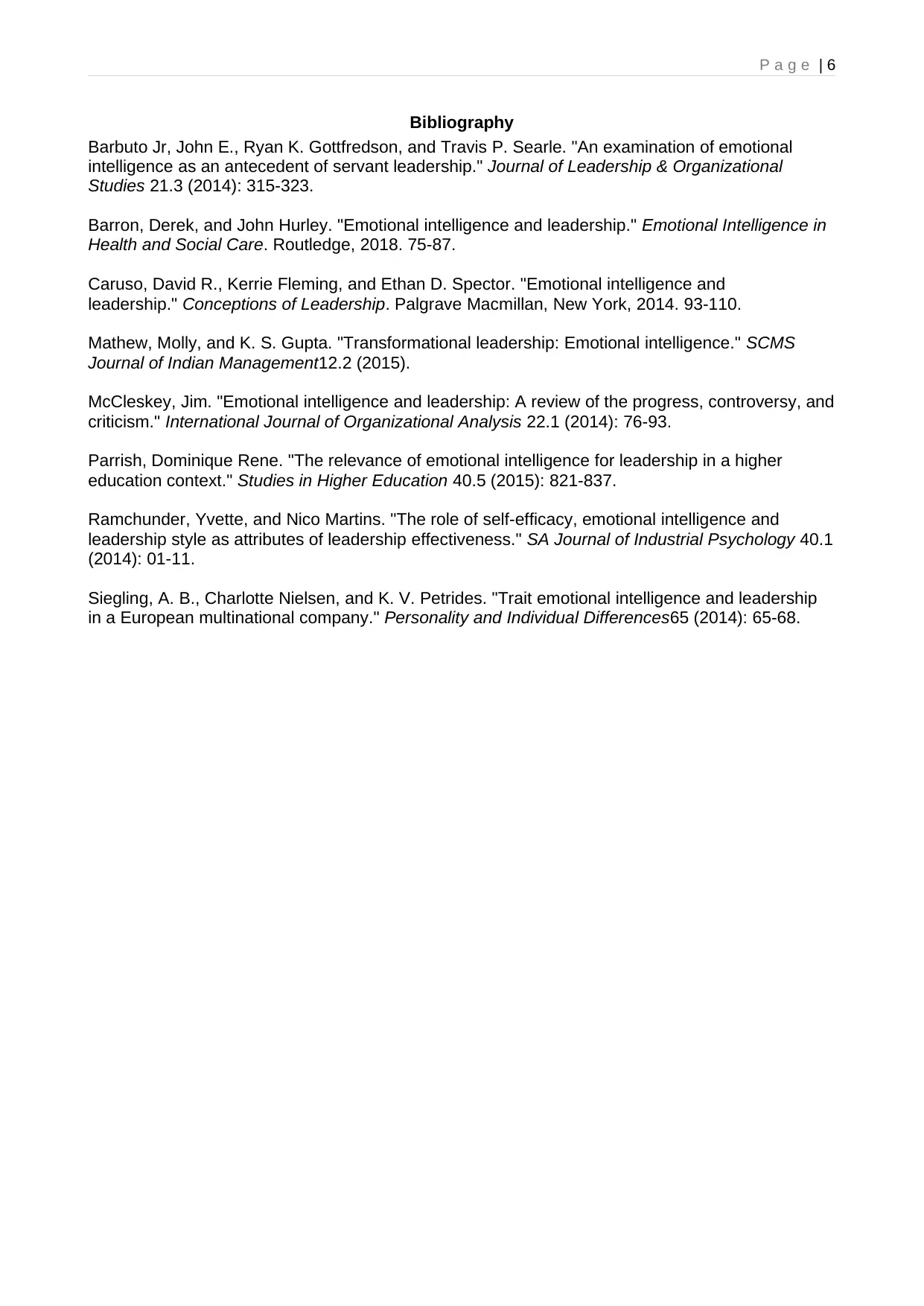
P a g e | 6
Bibliography
Barbuto Jr, John E., Ryan K. Gottfredson, and Travis P. Searle. "An examination of emotional
intelligence as an antecedent of servant leadership." Journal of Leadership & Organizational
Studies 21.3 (2014): 315-323.
Barron, Derek, and John Hurley. "Emotional intelligence and leadership." Emotional Intelligence in
Health and Social Care. Routledge, 2018. 75-87.
Caruso, David R., Kerrie Fleming, and Ethan D. Spector. "Emotional intelligence and
leadership." Conceptions of Leadership. Palgrave Macmillan, New York, 2014. 93-110.
Mathew, Molly, and K. S. Gupta. "Transformational leadership: Emotional intelligence." SCMS
Journal of Indian Management12.2 (2015).
McCleskey, Jim. "Emotional intelligence and leadership: A review of the progress, controversy, and
criticism." International Journal of Organizational Analysis 22.1 (2014): 76-93.
Parrish, Dominique Rene. "The relevance of emotional intelligence for leadership in a higher
education context." Studies in Higher Education 40.5 (2015): 821-837.
Ramchunder, Yvette, and Nico Martins. "The role of self-efficacy, emotional intelligence and
leadership style as attributes of leadership effectiveness." SA Journal of Industrial Psychology 40.1
(2014): 01-11.
Siegling, A. B., Charlotte Nielsen, and K. V. Petrides. "Trait emotional intelligence and leadership
in a European multinational company." Personality and Individual Differences65 (2014): 65-68.
Bibliography
Barbuto Jr, John E., Ryan K. Gottfredson, and Travis P. Searle. "An examination of emotional
intelligence as an antecedent of servant leadership." Journal of Leadership & Organizational
Studies 21.3 (2014): 315-323.
Barron, Derek, and John Hurley. "Emotional intelligence and leadership." Emotional Intelligence in
Health and Social Care. Routledge, 2018. 75-87.
Caruso, David R., Kerrie Fleming, and Ethan D. Spector. "Emotional intelligence and
leadership." Conceptions of Leadership. Palgrave Macmillan, New York, 2014. 93-110.
Mathew, Molly, and K. S. Gupta. "Transformational leadership: Emotional intelligence." SCMS
Journal of Indian Management12.2 (2015).
McCleskey, Jim. "Emotional intelligence and leadership: A review of the progress, controversy, and
criticism." International Journal of Organizational Analysis 22.1 (2014): 76-93.
Parrish, Dominique Rene. "The relevance of emotional intelligence for leadership in a higher
education context." Studies in Higher Education 40.5 (2015): 821-837.
Ramchunder, Yvette, and Nico Martins. "The role of self-efficacy, emotional intelligence and
leadership style as attributes of leadership effectiveness." SA Journal of Industrial Psychology 40.1
(2014): 01-11.
Siegling, A. B., Charlotte Nielsen, and K. V. Petrides. "Trait emotional intelligence and leadership
in a European multinational company." Personality and Individual Differences65 (2014): 65-68.
⊘ This is a preview!⊘
Do you want full access?
Subscribe today to unlock all pages.

Trusted by 1+ million students worldwide
1 out of 6
Related Documents
Your All-in-One AI-Powered Toolkit for Academic Success.
+13062052269
info@desklib.com
Available 24*7 on WhatsApp / Email
![[object Object]](/_next/static/media/star-bottom.7253800d.svg)
Unlock your academic potential
Copyright © 2020–2025 A2Z Services. All Rights Reserved. Developed and managed by ZUCOL.




